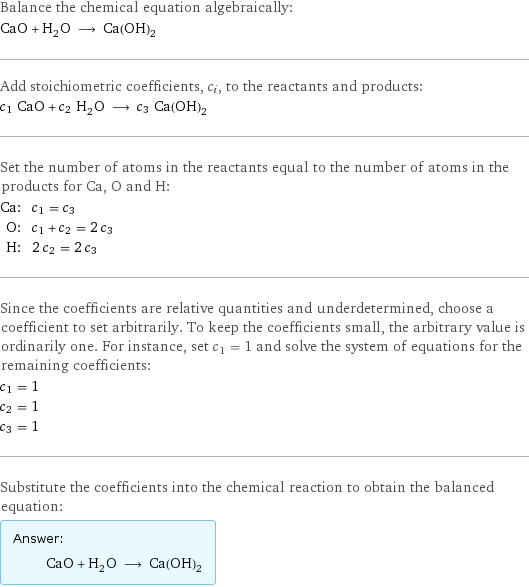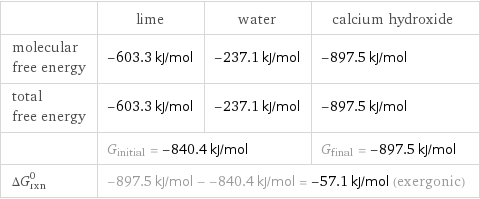Input interpretation

CaO lime + H_2O water ⟶ Ca(OH)_2 calcium hydroxide
Balanced equation

Balance the chemical equation algebraically: CaO + H_2O ⟶ Ca(OH)_2 Add stoichiometric coefficients, c_i, to the reactants and products: c_1 CaO + c_2 H_2O ⟶ c_3 Ca(OH)_2 Set the number of atoms in the reactants equal to the number of atoms in the products for Ca, O and H: Ca: | c_1 = c_3 O: | c_1 + c_2 = 2 c_3 H: | 2 c_2 = 2 c_3 Since the coefficients are relative quantities and underdetermined, choose a coefficient to set arbitrarily. To keep the coefficients small, the arbitrary value is ordinarily one. For instance, set c_1 = 1 and solve the system of equations for the remaining coefficients: c_1 = 1 c_2 = 1 c_3 = 1 Substitute the coefficients into the chemical reaction to obtain the balanced equation: Answer: | | CaO + H_2O ⟶ Ca(OH)_2
Structures

+ ⟶
Names

lime + water ⟶ calcium hydroxide
Reaction thermodynamics
Enthalpy

| lime | water | calcium hydroxide molecular enthalpy | -634.9 kJ/mol | -285.8 kJ/mol | -985.2 kJ/mol total enthalpy | -634.9 kJ/mol | -285.8 kJ/mol | -985.2 kJ/mol | H_initial = -920.7 kJ/mol | | H_final = -985.2 kJ/mol ΔH_rxn^0 | -985.2 kJ/mol - -920.7 kJ/mol = -64.47 kJ/mol (exothermic) | |
Gibbs free energy

| lime | water | calcium hydroxide molecular free energy | -603.3 kJ/mol | -237.1 kJ/mol | -897.5 kJ/mol total free energy | -603.3 kJ/mol | -237.1 kJ/mol | -897.5 kJ/mol | G_initial = -840.4 kJ/mol | | G_final = -897.5 kJ/mol ΔG_rxn^0 | -897.5 kJ/mol - -840.4 kJ/mol = -57.1 kJ/mol (exergonic) | |
Entropy

| lime | water | calcium hydroxide molecular entropy | 40 J/(mol K) | 69.91 J/(mol K) | 83 J/(mol K) total entropy | 40 J/(mol K) | 69.91 J/(mol K) | 83 J/(mol K) | S_initial = 109.9 J/(mol K) | | S_final = 83 J/(mol K) ΔS_rxn^0 | 83 J/(mol K) - 109.9 J/(mol K) = -26.91 J/(mol K) (exoentropic) | |
Equilibrium constant
![Construct the equilibrium constant, K, expression for: CaO + H_2O ⟶ Ca(OH)_2 Plan: • Balance the chemical equation. • Determine the stoichiometric numbers. • Assemble the activity expression for each chemical species. • Use the activity expressions to build the equilibrium constant expression. Write the balanced chemical equation: CaO + H_2O ⟶ Ca(OH)_2 Assign stoichiometric numbers, ν_i, using the stoichiometric coefficients, c_i, from the balanced chemical equation in the following manner: ν_i = -c_i for reactants and ν_i = c_i for products: chemical species | c_i | ν_i CaO | 1 | -1 H_2O | 1 | -1 Ca(OH)_2 | 1 | 1 Assemble the activity expressions accounting for the state of matter and ν_i: chemical species | c_i | ν_i | activity expression CaO | 1 | -1 | ([CaO])^(-1) H_2O | 1 | -1 | ([H2O])^(-1) Ca(OH)_2 | 1 | 1 | [Ca(OH)2] The equilibrium constant symbol in the concentration basis is: K_c Mulitply the activity expressions to arrive at the K_c expression: Answer: | | K_c = ([CaO])^(-1) ([H2O])^(-1) [Ca(OH)2] = ([Ca(OH)2])/([CaO] [H2O])](../image_source/19e212f4367afcb9d42cb505be8c5ce4.png)
Construct the equilibrium constant, K, expression for: CaO + H_2O ⟶ Ca(OH)_2 Plan: • Balance the chemical equation. • Determine the stoichiometric numbers. • Assemble the activity expression for each chemical species. • Use the activity expressions to build the equilibrium constant expression. Write the balanced chemical equation: CaO + H_2O ⟶ Ca(OH)_2 Assign stoichiometric numbers, ν_i, using the stoichiometric coefficients, c_i, from the balanced chemical equation in the following manner: ν_i = -c_i for reactants and ν_i = c_i for products: chemical species | c_i | ν_i CaO | 1 | -1 H_2O | 1 | -1 Ca(OH)_2 | 1 | 1 Assemble the activity expressions accounting for the state of matter and ν_i: chemical species | c_i | ν_i | activity expression CaO | 1 | -1 | ([CaO])^(-1) H_2O | 1 | -1 | ([H2O])^(-1) Ca(OH)_2 | 1 | 1 | [Ca(OH)2] The equilibrium constant symbol in the concentration basis is: K_c Mulitply the activity expressions to arrive at the K_c expression: Answer: | | K_c = ([CaO])^(-1) ([H2O])^(-1) [Ca(OH)2] = ([Ca(OH)2])/([CaO] [H2O])
Rate of reaction
![Construct the rate of reaction expression for: CaO + H_2O ⟶ Ca(OH)_2 Plan: • Balance the chemical equation. • Determine the stoichiometric numbers. • Assemble the rate term for each chemical species. • Write the rate of reaction expression. Write the balanced chemical equation: CaO + H_2O ⟶ Ca(OH)_2 Assign stoichiometric numbers, ν_i, using the stoichiometric coefficients, c_i, from the balanced chemical equation in the following manner: ν_i = -c_i for reactants and ν_i = c_i for products: chemical species | c_i | ν_i CaO | 1 | -1 H_2O | 1 | -1 Ca(OH)_2 | 1 | 1 The rate term for each chemical species, B_i, is 1/ν_i(Δ[B_i])/(Δt) where [B_i] is the amount concentration and t is time: chemical species | c_i | ν_i | rate term CaO | 1 | -1 | -(Δ[CaO])/(Δt) H_2O | 1 | -1 | -(Δ[H2O])/(Δt) Ca(OH)_2 | 1 | 1 | (Δ[Ca(OH)2])/(Δt) (for infinitesimal rate of change, replace Δ with d) Set the rate terms equal to each other to arrive at the rate expression: Answer: | | rate = -(Δ[CaO])/(Δt) = -(Δ[H2O])/(Δt) = (Δ[Ca(OH)2])/(Δt) (assuming constant volume and no accumulation of intermediates or side products)](../image_source/0c04b4d67397314edc728540ecc3c0b1.png)
Construct the rate of reaction expression for: CaO + H_2O ⟶ Ca(OH)_2 Plan: • Balance the chemical equation. • Determine the stoichiometric numbers. • Assemble the rate term for each chemical species. • Write the rate of reaction expression. Write the balanced chemical equation: CaO + H_2O ⟶ Ca(OH)_2 Assign stoichiometric numbers, ν_i, using the stoichiometric coefficients, c_i, from the balanced chemical equation in the following manner: ν_i = -c_i for reactants and ν_i = c_i for products: chemical species | c_i | ν_i CaO | 1 | -1 H_2O | 1 | -1 Ca(OH)_2 | 1 | 1 The rate term for each chemical species, B_i, is 1/ν_i(Δ[B_i])/(Δt) where [B_i] is the amount concentration and t is time: chemical species | c_i | ν_i | rate term CaO | 1 | -1 | -(Δ[CaO])/(Δt) H_2O | 1 | -1 | -(Δ[H2O])/(Δt) Ca(OH)_2 | 1 | 1 | (Δ[Ca(OH)2])/(Δt) (for infinitesimal rate of change, replace Δ with d) Set the rate terms equal to each other to arrive at the rate expression: Answer: | | rate = -(Δ[CaO])/(Δt) = -(Δ[H2O])/(Δt) = (Δ[Ca(OH)2])/(Δt) (assuming constant volume and no accumulation of intermediates or side products)
Chemical names and formulas

| lime | water | calcium hydroxide formula | CaO | H_2O | Ca(OH)_2 Hill formula | CaO | H_2O | CaH_2O_2 name | lime | water | calcium hydroxide IUPAC name | | water | calcium dihydroxide
Substance properties

| lime | water | calcium hydroxide molar mass | 56.077 g/mol | 18.015 g/mol | 74.092 g/mol phase | solid (at STP) | liquid (at STP) | solid (at STP) melting point | 2580 °C | 0 °C | 550 °C boiling point | 2850 °C | 99.9839 °C | density | 3.3 g/cm^3 | 1 g/cm^3 | 2.24 g/cm^3 solubility in water | reacts | | slightly soluble surface tension | | 0.0728 N/m | dynamic viscosity | | 8.9×10^-4 Pa s (at 25 °C) | odor | | odorless | odorless
Units
